
The Deutzen Hofje or Deutzenhofje is a 17th-century hofje on the Prinsengracht 857 in Amsterdam. It is the largest hofje built in the 17th century.

The Deutzen Hofje or Deutzenhofje is a 17th-century hofje on the Prinsengracht 857 in Amsterdam. It is the largest hofje built in the 17th century.
Three double canal mansions on the Prinsengracht are part of the hofje, but only the richly ornamented middle gate was used by the hofje pensioners. The two outer double houses are rental homes that add to the hofje's income. The gatehouse is an unusual canal mansion because the entrance is at street level, meant for use by the pensioners. Generally Amsterdam canal mansions have a staircase leading to the bel-etage.
The hofje was built in 1692 from the proceeds of the bequest by Agneta Deutz, who had purchased the land and named the regents before her death. She intended it to be used by old servants and poor relations. On the gablestone in front is inscribed:
Agneta Deutz laat hier haar liefde en godsdienst blijken
Den Armen tot een troost, tot voorbeeld aan de rijken
Anno 1695
On the top floor the regent's room has a view over the canal. There a portrait of Agneta can still be seen. The hofje had room originally for 19 pensioners. The garden has an old pump and is planted with flowers in the summer months. In 1964 it was expanded to 31 pensioners homes. Old women are still welcome to live there.

The Prinsengracht is a 3.2-kilometer (2.0 mi)-long canal that runs parallel to the Keizersgracht in the center of Amsterdam. The canal, named after the Prince of Orange, is the fourth of the four main canals belonging to the canal belt.
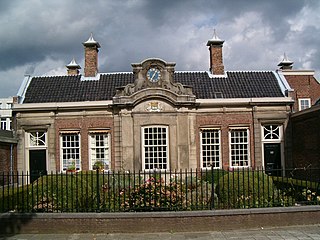
The Hofje van Noblet is a hofje in Haarlem, Netherlands.

The Hofje van Staats is a hofje in Haarlem, Netherlands, on the Jansweg 39, close to the Haarlem railway station.

The Hofje van Loo is a hofje on the Barrevoetstraat 7 in Haarlem, Netherlands.
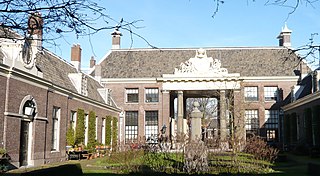
The Teylershofje is a hofje in Haarlem, Netherlands with 24 houses.

The Hofje in den Groenen Tuin is a hofje in Haarlem, Netherlands.

The Hofje van Willem Heythuijsen is a hofje in Haarlem, Netherlands. It was founded in 1650 by the testament of Willem van Heythuysen on the site of his summer residence outside the city walls of Haarlem on land that was considered Heemstede property until it was annexed in 1927. It is one of the few hofjes of Haarlem to be built outside the city walls. It has a 'T' shape and has a small open courtyard and a garden still intact.

The Jordaan is a neighbourhood of the city of Amsterdam, Netherlands. It is part of the borough of Amsterdam-Centrum. The area is bordered by the Singelgracht canal and the neighbourhood of Frederik Hendrikbuurt to the west; the Prinsengracht to the east; the Brouwersgracht to the north and the Leidsegracht to the south. The former canal Rozengracht is the main traffic artery through the neighbourhood.
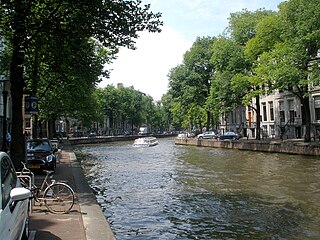
The Gouden Bocht is the most prestigious part of the Herengracht in Amsterdam, Netherlands, between Leidsestraat and Vijzelstraat.

Amsterdam, capital of the Netherlands, has more than 100 kilometers (62 mi) of grachten (canals), about 90 islands and 1,500 bridges. The three main canals, dug in the 17th century during the Dutch Golden Age, form concentric belts around the city, known as the Grachtengordel. Alongside the main canals are 1550 monumental buildings. The 17th-century canal ring area, including the Prinsengracht, Keizersgracht, Herengracht and Jordaan, were listed as UNESCO World Heritage Site in 2010, contributing to Amsterdam's fame as the "Venice of the North".
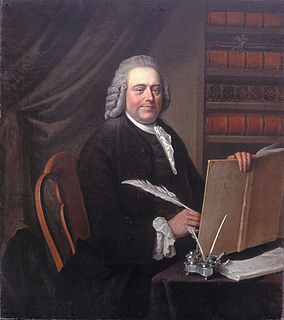
Pieter Teyler van der Hulst was a wealthy Dutch Mennonite merchant and banker, who died childless, leaving a legacy of two million florins to the pursuit of religion, arts and science in his hometown, that led to the formation of Teyler's Museum. This was not the value of his entire estate. He also founded Teylers Hofje in his name, and made important donations to individuals in the Mennonite community.

The Vrouwe- en Antonie Gasthuis is a hofje on the Klein Heiligland 64a in Haarlem, Netherlands. It is open on weekdays from 10-17.00.

The Proveniershuis is a hofje and former schutterij on the Grote Houtstraat in Haarlem, Netherlands.

The Hofje van Codde en Beresteyn is a hofje in Haarlem, Netherlands. The current building is from 1968 and is located on the J. Cuyperstraat, which is named for the architect who designed the Cathedral of Saint Bavo next door, Joseph Cuypers. This hofje is the wealthiest hofje foundation in Haarlem with the most modern facilities for its inhabitants. Poor (devote) Catholic women of Haarlem 60 years and older are still welcome to live there for free.
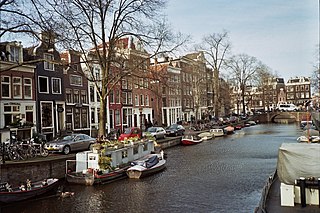
The Spiegelgracht is a canal in the centre of Amsterdam, located near the Prinsengracht. Built in the 16th century, it is a part of the Canals of Amsterdam which have been designated as UNESCO World Heritage Sites.

A canal house is a house overlooking a canal. These houses are often slim, high and deep. Because of the danger of flooding the front door is sometimes higher up and only accessible via stairs. The floor of the main storey lies about seven to nine steps above street level. Many stoops disappeared in the 19th century when entrances were moved to the basement.

The Grachtengordel is a neighborhood in Amsterdam, Netherlands located in the Centrum district. The seventeenth-century canals of Amsterdam, located in the center of Amsterdam, were added to the UNESCO World Heritage List in August 2010. The Amsterdam Canal District consists of the area around the city's four main canals: the Singel, the Herengracht, the Keizersgracht, and the Prinsengracht. From the Brouwersgracht, the canals are generally parallel with one another, leading gradually southeast into the Amstel river.

Isabella Henriette van Eeghen, usually cited as I. H. van Eeghen, was a Dutch historian who worked for the Stadsarchief Amsterdam.
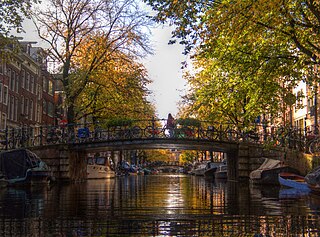
The Egelantiersgracht in Amsterdam is a canal in the Jordaan neighbourhood in the Amsterdam-Centrum borough. The canal lies between the Prinsengracht and the Lijnbaansgracht.

The Nieuwe Keizersgracht is a canal in Amsterdam, part of the eastern Grachtengordel.
| Dutch Rijksmonument 4431 |
| Wikimedia Commons has media related to Deutzenhofje . |